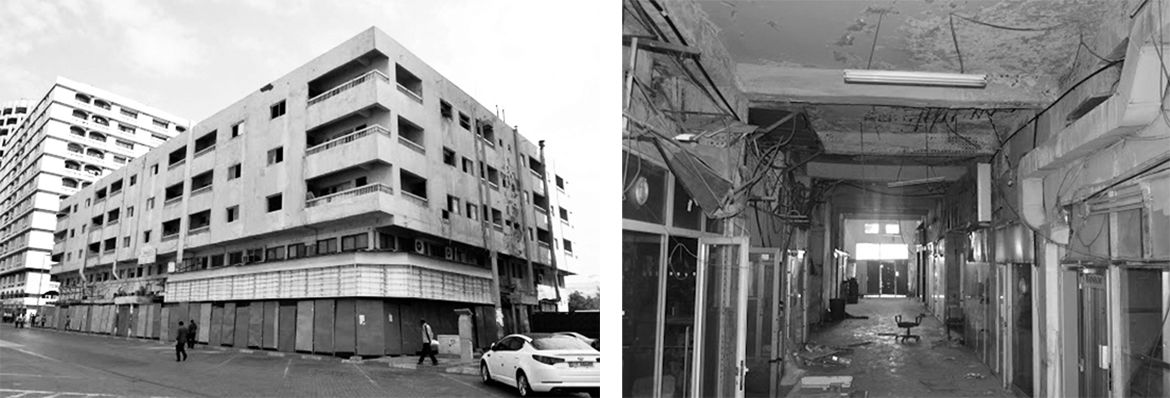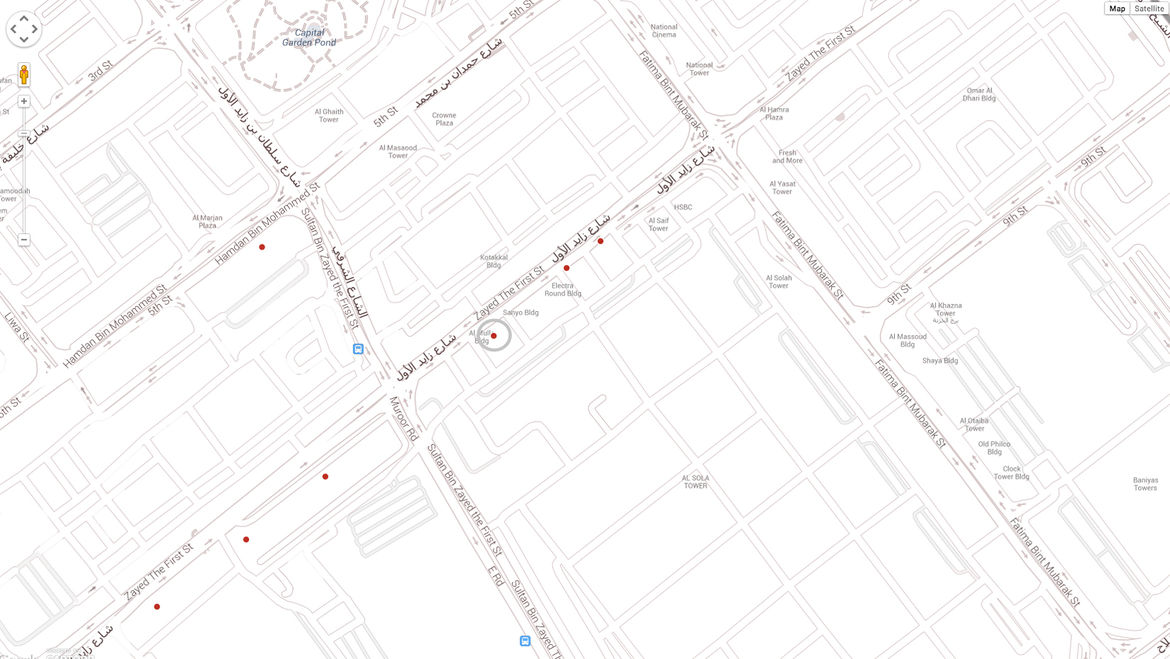14. Al-Mullah Building 1970s
Architect Unknown
Electra Street/Sheikh Zayed the First Street
Bus Routes 007, 008, 032, 034
The Al-Mullah building, named after its owner, has been awaiting demolition for two years. The shops have been cleared and the entrance has been boarded up, yet social life still thrives around the building, and people congregate as though shops and restaurants were open. Chai is taken from surrounding areas and consumed while standing near the building. Styrofoam cups, pop cans, tea bags, and flyers for bachelor rooms litter the periphery, and hint at the place’s community life.
Signs of decay are obvious: the building’s paint is peeling and the metal railings on the balconies have tarnished. The Al-Mullah building’s functional, box-like simplicity features small windows, and its four floors are now out of place among Electra Street’s high rises. However, appearance is not the first thing you notice about the Al-Mullah. In fact, as you walk down Electra Street, the building almost seems to be an afterthought to the social space it has birthed. On Thursday and Friday evenings, men sit in circles on the grass in front and to the left of the building with their shoes off. On either side, two small car parks offer additional space. Here, up to thirty men sit on the curb or stand in groups, until long after the sun has set, and two street lamps encourage social interaction into the night. To the back of the building, a much larger car park runs the length of the block, where parked trucks and stopped taxis add to the crowd. Noticing the number of cab drivers, I began asking them if they knew anything about the Al-Mullah building, and found that many went there every day during their breaks.
Why did the building become a public hub for the South Asian population that frequents it? Since the 1970s, the building and the space around it (referred to as the Al-Mullah area), have served as an important shared meeting place for South Asian male migrants. Today, men come from as far as Musaffah, Dubai, and Sharjah to meet friends and acquaintances. As one man remarked, "we come here just to say, ‘How are you?’"
This informal space evolved organically from the bottom up. In contrast to the top-down planned public spaces of Abu Dhabi, spaces such as the Al-Mullah area are unofficial and trump the rigid city grid. In Abu Dhabi, car-centered urban planning resulted in widened sidewalks. Around the Al-Mullah building, however, this wasted space has been reclaimed. In many public areas, South Asian migrants are excluded because of their ethnicity and class, at times seeming almost apologetic for their presence in public. In the Al-Mullah area, however, you feel as though you were a guest.
Life here is dense, squeezing its way around one of the busiest intersections in Abu Dhabi, and leaving cups and other artifacts to mark its place. Such spaces are threatened by the constant competition to build vertically for residents with higher incomes. This tendency leaves less space for informal places, whose loss is felt deeply, as they sustain the pedestrian and central nature of downtown. The area might cater to a very specific population, but it nonetheless creates an outdoor life. Even boarded up and hollowed, the Al-Mullah building still interacts with the sidewalk and street, and creates a sense of place.
One of the building’s most exciting architectural features is an internal boulevard that linked the entrances on all four sides of the building together. The connected entrances were marked on the outside with pillars covered in black tile. From a bird’s-eye view, the internal boulevard would have looked like a cross. Inside the building, shops, small grocery stores, a restaurant, and a barber shop attracted customers. From the beginning, interaction with the street was built into the Al-Mullah’s design.
What the Al-Mullah building teaches us about urban space is that certain places come together, despite master plans, in an effort to make cities more livable. For the South Asian low-income population, who might feel excluded from luxury malls, hotels and the new Central Market, the Al-Mullah building provides a space to share news from home, fend off homesickness, and retain bonds. The building’s four-decade history has allowed for the formation of collective memory within the space, and the fact that people continue to hang around the building even after it has been cleared says something about how architecture can go well beyond its intended function. Such precious sites take time to grow, and are therefore difficult to let go of. They remind us that, ultimately, people – not plans – are the true shapers of cities.

